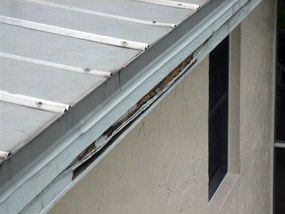Metal roofing is built to last. A properly installed metal roof can stand the test of time and the brutal forces of the weather. However, even the toughest of metal roofs will eventually need roof repair help. Kelly Roofing can help you will the care your metal roof needs to last for years more. We take away the stress of roof repair and replacement by caring, communicating and being consistent so you can enjoy a long-lasting, worry-free roof. Connect with us today if you’re in need of flat roof repair.
Listed below are the most common Metal Roof Repair Problems.
Common Metal Roof Repairs
Slipping: Delaminating / Sliding
Interlocking Metal Panels are coming unclipped and sliding. This is caused by improper fastening. They are designed to be fastened in a specific area, increasing wind resistance and ensuring that both sides of the panel are attached to the roof. Without lifting up every panel and breaking the clips, it’s impossible to tell if the problem is consistent throughout the entire roof or just the areas visible. Generally, if the roof was installed by the same crew or person, the problem is consistent. There’s a good possibility this roof will continue to experience this problem in the future, especially after high wind events.
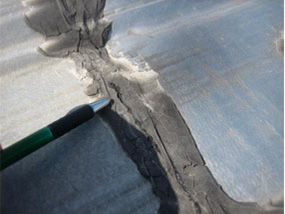
Offset Not correct
Metal panels are not a waterproofing material. When installed correctly, they do “shed” water. However, if installed on a flat roof, they would allow massive seepage. The way metal panels work is by their overlapping design. As the previous layer is covered by the next it creates a stair step watershed design, disallowing seepage. This stair step design also has a vertical component to it. If each row is not offset correctly, water may enter the system.
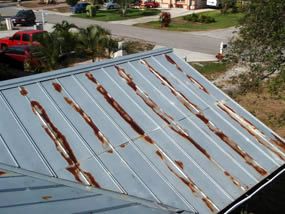
Improper Fastener Type
When two different types of metals come in contact a chemical reaction occurs: Electrolysis uses moisture as catalysis at a molecular level to pass ions from one metal to the other. The process causes a deterioration of both metals similar to the effects of rust. Using the wrong type of fasteners causes a real concern due to the importance of the fastener itself. Electrolysis causes the fastener puncture to deteriorate and widen, allowing a water path and seepage. Incompatible fastener types were used and electrolysis is occurring.
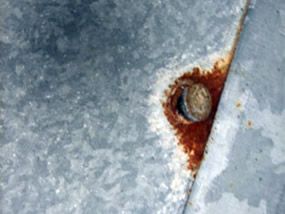
Backwater Laps
When installing a roof system it is important to always start at the lowest point and proceed upward toward the roof’s peak. This ensures that each layer of materials overlaps the previous. Even on flat roofs, this principle is important. As water travels, on a pitch or on a flat roof, if two seams are lapped in backwards a backwater lap occurs. This can “cup” water and force it under the layers, causing leaks.
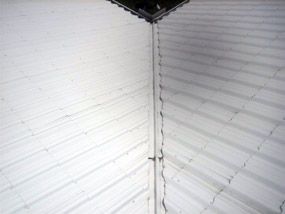
Valley Metal Buckling
Valley metal is installed by crimping the valley center, fastening the entire length of both edges and then applying mastic to cover the valley metal edge and fasteners. When valley metal is not properly pressed, fastened and/or sealed it causes buckling and waving. Since a valley is designed to channel water between two pitch areas a valley receives more water flow than any other part of the roof. Valley metal buckling disrupts the immediate flow of water and creates water vortices, a circular flow of water that leads to roof seepage.

Vent Not Lapped/Sealed Correctly
As with all rooftop objects it is important that proper water flow and installation are considered. Flashing that is not layered correctly and sealant applied in the right junction areas allow water seepage. The vent flange on this roof was not installed correctly with the proper overlap procedure. Sealant has done a good job covering up the installation error, but is now showing signs of deterioration. Adding sealant may prevent seepage temporarily but is not a roof cycle solution. The vent should be replaced and installed correctly.
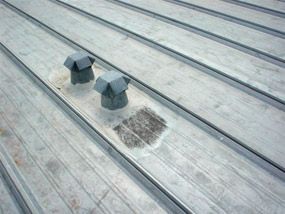
No Ell Flashing Installed
Whenever a roof surface meets a vertical surface ell flashing is needed to bridge the transition and protect from seepage. On this roof Kelly Roofing found no ell flashing was installed at this detail. Although sealant may have helped avoid leaks, over time sealant breaks down. The correct technique is to install ell flashing here.
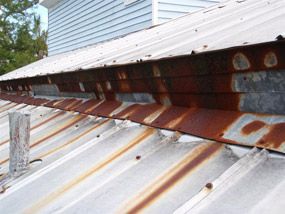
Fasteners In The Valley
Since a valley is designed to channel water between two pitch areas a valley receives more water flow than any other part of the roof. A standard installation guideline on all roof systems is to never install fasteners in the valley’s center. Exposed valley fasteners disrupt the immediate flow of water. Because valleys are transition areas and absorb building movement, fasteners installed in the valley center uplift and allow water seepage. The only way to properly repair this issue is by replacing the valley flashing.

Off Ridge Vents not Angled
Vents are installed on the roof to allow for attic airflow. These vents should not be longer than four feet in length and should be installed at an angle. As water flows down the roof it often is blocked behind the vent creating a small area of water ponding. Ponding water is water sitting on any asphalt roofing material longer than 48 hours without run-off or evaporation. As the water sits it magnifies the sun’s rays and works on breaking down the sealant and underlayment used to seal the vent to the roof. The correct way to fix this issue is to install a new vent.
Fair/Unfair Metals Touching
When two different types of metals, fair and unfair as they are called, come in contact a chemical reaction occurs. Electrolysis uses moisture as catalysis at a molecular level to pass ions from one metal to the other. The process causes a deterioration of both metals similar to the effects of rust. Using two different types of metal causes electrolysis and the rapid breakdown of metal.
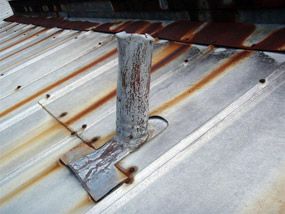
Torn/Cracked/Broken Surface
As a roof expands and contracts the roof system moves. This is a daily occurrence and is associated with Thermal Shock. During movement the metal panels bind against each other. Sometimes a tree branch or flying debris may impact the roof causing damage. 3rd party damage is another issue. As people walk across the roof they can cause damage. The metal panels on this Naples roof have been damaged. Since this leaves the underlayment showing, it is our recommendation these areas are repaired.
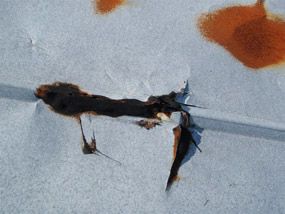
Improper Number of Fasteners
Metal is designed to be installed using special self-sealing screws. Each metal panel has a designated uplift and manufactures specify exactly how many fasteners per square foot are required. If metal panels are fastened outside the specifications the manufacturer’s warranty is voided and the roof assembly is out of code. This also leaves the roof susceptible to roof blow-off in the event of strong winds. However, most of the good roofing contractors still install extra fasteners in order to achieve the enhanced wind resistance.

Fasteners Uplifting
“High fasteners” are a serious problem. During roof installation it’s easy for installers to forget about proper pressure setting on their screw guns. In most cases too many drills were hooked up to a single electrical line that was not sufficient to drive each fastener fully. At time of installation only the severe “high screws” are noticeable. Over time, expansion and contraction causes the screws to uplift. “High fasteners” begin to lift allowing a place for water to run into and under the system. Rusting and seepage can occur.
The most susceptible area on a roof to wind damage is the cap. Cap flashings are used to cover the hip and ridge areas of two adjoining decks. Most installers see this area as a simple trip piece and do not install enough fasteners to hold it in place during a strong wind event. This should be replaced as the sun is now deteriorating the roof’s underlayment and water is able to travel directly under the metal panels.
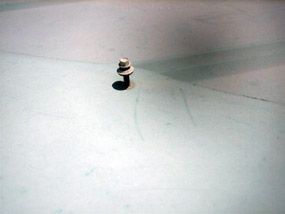
Flashing Rusting
Steel metal flashings exposed to the elements can rust over time. Today’s flashings are made of galvanized metal, a process that protects the steel core from rusting. Rust cannot be simply sealed over, as it will continue to grow. The rust needs to be cut out and a new flashing installed, then sealed properly. Since the rust is open to the surface and flashings are vital to the integrity of the roof system, we suggest repairing the rusted flashing areas before seepage causes structural damage.
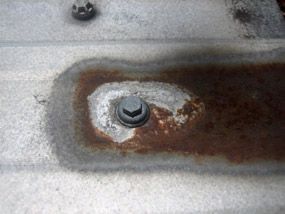
Gable End Flashing Not Correct
Gable ends are where a valley terminates into a roof’s surface, rather than running the entire length to the roof’s edge. They are quite common and add to the roof’s design. However, if not correctly detailed with flashings and sealants, the gable end is an area of concern. With the valley channeling large amounts of water to the gable end area there is an increased chance of seepage. In fact, it is the #1 repair area on all roof systems. Adding more sealant may stop the seepage for a year or so, but the only correct way to fix this area is by removing the flashings and installing them correctly. This will minimize the dependence on sealants, which will deteriorate over time.
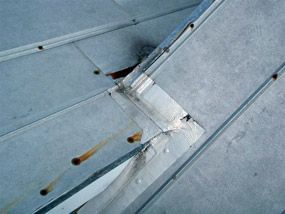
Plastic Boots Used
As you know, plastic typically dries out rather quickly in our environment. The sun’s UV rays cause oil migration much the same as it does to exposed asphalt. On this roof a plastic stack flashing was used to seal the pipe. A gap between the pipe and surrounding flashing is visible and allows seepage. This boot should be removed and replaced with a new lead boot.
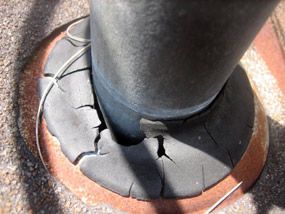
Ell Flashing Uplifting
Ell flashing should be nailed every six inches on center. Not enough fasteners were used and the sealant has deteriorated. We suggest sealing the underside of the ell flashing and installing the correct number of fasteners as specified by code. On this roof another layer of membrane should be installed to cover the ell-flashing flange and provide a more aesthetically pleasing transition area.
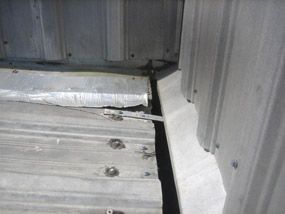
Flashing Seams Separating
Flashing seams must be overlapped correctly and an adequate amount of sealant placed in between the overlap area to ensure proper waterproofing at the ell flashing transition area. The correct way to repair this area is to replace the flashing with new. That is the only way to ensure the flashing detail area will not leak.

Pitch Transition not Flashed
Whenever two different roof pitches transition a specially designed flashing is needed to bridge the slope change. Over time the sealant will deteriorate and allow leaks. The pitch transition on your roof does not have any flashing in it. Eventually the roofing materials and mastic used to seal this area will cause interior damages.
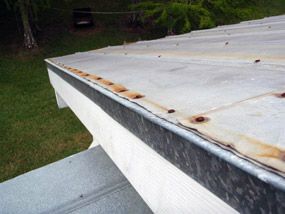
Pan Roof Tie-In not Correct
Vents are installed on the roof to allow for attic airflow. These vents should not be longer than four feet in length and should be installed at an angle. As water flows down the roof it often is blocked behind the vent creating a small area of water ponding. Ponding water is water sitting on any asphalt roofing material longer than 48 hours without run-off or evaporation. As the water sits it magnifies the sun’s rays and works on breaking down the sealant and underlayment used to seal the vent to the roof. The correct way to fix this issue is to install a new vent. These vents were not installed with the correct angle and water is ponding behind them.
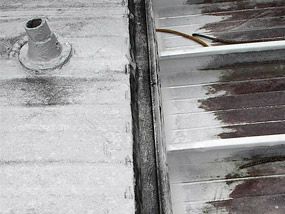
Roof Recovered
We do not recommend recovering any roof system. Often roofers will advise consumers to simply install wood strips over the existing roof and install the new system on the wood batons as seen on this roof. This causes trapped moisture and over time the original roof system will “bake”, causing rapid deterioration.
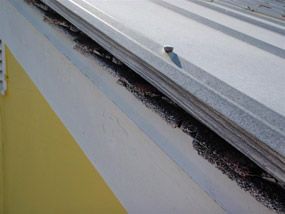
Improper Fastener Installation
It is important that all fasteners are installed perpendicular to the roof’s surface and driven in at a perfect 90 degree angle. On this roof are areas where the fasteners were not driven straight in and the fastener heads are lifted slightly. Over time this can and will damage the roof system and allow seepage.
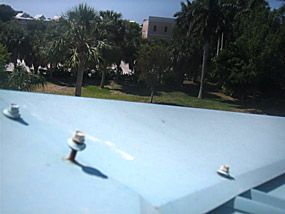
Flat Tie-In not Sealed Properly
The junction between your pitch roof and the flat roof is called the “tie-in”. This area is specifically important because there are two different roofing materials joining. This roof shows evidence that the tie-in area is not sealed properly. It is also very important that the two roof systems have the correct flashing detail and extra sealant protection.
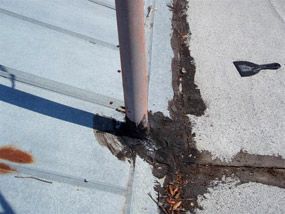
No Sealant at Flashings
Although flashings bridge transitions in the roof, when not sealed properly they are ineffective. Flashing is designed to turn corners and breaks in a roof, which tend to have more movement than other areas. If not sealed properly, these flashings do little to stop water from entering the roof system. Here are voids in the roof’s flashings where sealants were not applied correctly. This is allowing water to enter the flashing detail area. This can be repaired with minimal expense.
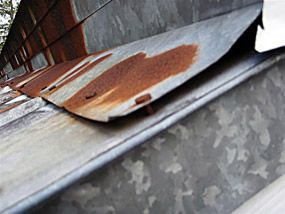
Boot Lapped/Sealed Correctly
Steel metal flashings exposed to the elements can rust over time. Today’s flashings are made of galvanized metal, a process that protects the steel core from rusting. Cool Roofing Systems found rusted flashings on this roof. Rust cannot be simply sealed over, as it will continue to grow. The rust needs to be cut out and a new flashing installed, then sealed properly. Since the rust is open to the surface and flashings are vital to the integrity of your roof system, we suggest repairing the rusted flashing areas before seepage causes structural damage.
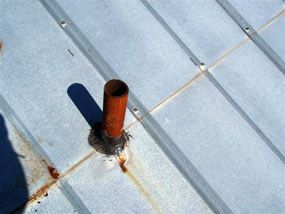
Ell Flashing Not Sealed Properly
Ell flashing bridges the transition from the roof’s surface and a wall or upright surface such as a curb. On this roof the ell flashing has not been sealed properly and the shingles are peeling back from the flashing allowing seepage. This can be corrected by removing the area and installing mastic sealant correctly. New membrane may need to be installed in this area. Also, if the ell flashing cannot be cleaned or has too many old fastener holes in it, the entire flashings detail area may need to be replaced.
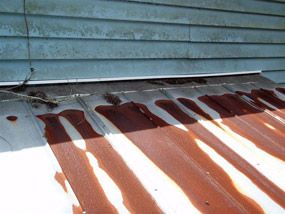
Ell Flashing Behind Wall Surface
Ell flashing is designed to bridge the roof to wall transition and allow for protection against water intrusion. Water which runs down the roof and wall is caught by the ell flashing and channeled to the roof’s edge. It is important that the ell flashing’s end be flared so it sticks out past the siding/stucco. On this roof the installers did not flare the flange end and it terminates behind the siding/stucco. This provides a direct path for water to flow behind the wall surface and into the building. Often this type of leak takes time to show and may only be noticeable in heavy rains and the wall needs to soak enough to be evident. The only correct way to repair this issue is to add a layer of membrane over the existing flashing that directs water flow out and away from the wall. Some roofers may suggest cutting out the old flashings and installing new. We do not suggest this, as it is impossible to replace the wall surfacing material and regain integrity.
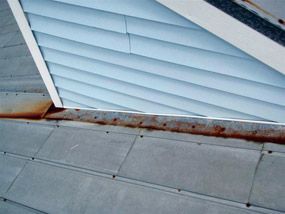
No Wall Cap/Coupling
Separation firewalls are designed to extend past the roof level and protect against spreading flames in the unlikely event of a fire. Many times these walls are simply stuccoed and painted. Over time the paint deteriorates, often at rates faster than walls due to the direct sunlight they receive, and allow moisture to seep into the wall’s core. Under a maintenance program these wall caps can be coated using an elastomeric paint sealant. Other times it is best to use some type of wall cap to permanently protect the wall top area. When moisture enters the wall it causes moisture bleed out and swelling. The additional moisture content is trapped and cannot evaporate causing further damages to fasteners, flashings and framing. The swelling can rust out concrete rebar and steel straps, both structural components of the wall. The correct way to fix this is to treat the wall top as a roof and install a roof system on it. This can be achieved by installing a metal coupling or a flat roof membrane with flashing on all four sides of the wall’s top. The flat roof membrane is a better detail as it provides one continuous piece and protection without added maintenance.
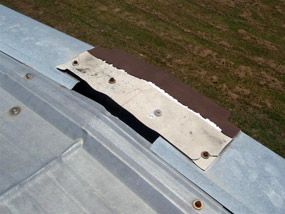
Counter Flashing Loose
Counter flashing is metal flashing installed into the wall to protect the roof membrane from coming loose from the wall as it transitions from the roof area. Counter flashing can also be used in conjunction with ell flashing at the same detail area. On this roof the counter flashing, which has a concealed return flashing cut and installed into the wall, has come loose from the wall and is allowing water to enter. Counter flashing is an older flashing technique and requires constant maintenance by re-fastening and re-sealing the top wall cut to disallow seepage. This area should be repaired before interior damage occurs.
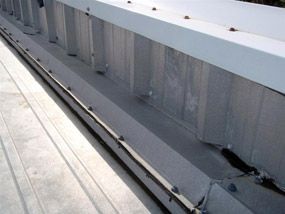
Drip Edge with Flat Shelf
Often associated with gutter installation and plumb fascia boards, perimeter drip edge flashings can create a shelf or ledge about three inches from the roof’s edge. This shelf creates a flat roof area at the roof’s perimeter. Since this roof system is not a flat roof, the perimeter flashings are not designed to allow for sitting water. During light rains and morning dew water seeps under the roof system and deteriorates the perimeter decking sub-fascia board and fascia board. This can be resealed as a temporary fix, but should be replaced for a more permanent measure.
